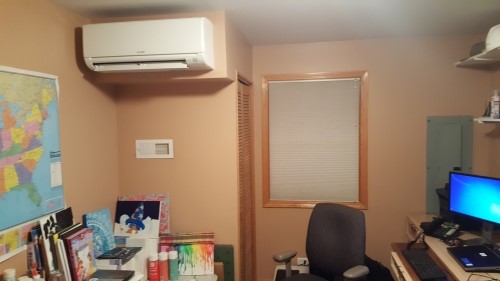DUCTLESS HEATING REPLACES NOISY FURNACE IN HOFFMAN ESTATES, IL

When our homeowners in Hoffman Estates needed to replace their furnace, they were looking for a better option than the setup they already had. The solution was a ductless heating system that provides better heat with less noise and lower monthly bills.
This split ranch home near Evergreen Park had a traditional forced air gas furnace and central air conditioning system. It treated both the main part of the house and an addition that a previous owner built years ago.
However, the HVAC system they had wasn’t ideal. The setup was loud – especially the heat.
Our homeowners wanted an HVAC system that was quieter and took up less space.
Now, this split ranch home has quieter, more efficient heating and cooling – and more closet space.
We’ll take a look at the HVAC challenges this suburban home presented. And, we’ll see how our solution overcome those obstacles.
Problem: The furnace in a Hoffman Estates, IL split ranch home was noisy and took up most of the room in a closet. The homeowners wanted something quieter that took up less space when it was time to replace the unit.
Solution: Installed an outdoor heat pump with a wall-mounted ductless air handler in the home office and a floor-unit ductless air handler in the living room.
Heating and cooling in a split ranch home
This growth was coupled with a housing boom that resulted in many of those classic-looking ranch homes you see today.
Many homeowners added ductwork and AC later on. That meant finding space anywhere possible in the house for the equipment.
Today, there are better solutions for these heating and cooling challenges.
How well does ductless heating work in a ranch home?
Ductless heating makes a big difference in an older suburban home like this split ranch. These systems:
- Don’t require ductwork to circulate the air
- Use an outdoor heat pump instead of an indoor furnace
- Are whisper-quiet even at full power
- Eliminate hot and cold spots throughout the home
- Use less energy, resulting in lower heating and cooling bills
First off, we didn’t need to install an indoor component to provide warmth. Instead, an outdoor heat pump handles the heat and the air conditioning.

Our homeowners got their closet space back when they got rid of their old furnace.

The air handlers are literally whisper-quiet. At their loudest, they register around 20 decibels – the same as leaves rustling outside.
Saving money and eliminating hot and cold spots with zoned HVAC
We also mentioned how these systems cost less to run than traditional furnaces. And, we said it did a better job of heating the house evenly. Well, how does it do all that?
The answer is “Zoned HVAC.”
Take your normal setup: There’s a thermostat somewhere in the house. Usually, it’s in the living room.
When it’s cold out, you set that gauge to the temperature you want for the home. When the house gets colder than that, it tells the furnace to kick on.
There are two problems here:
- The heat doesn’t go on until it’s already too cold
- Not every room is the same temperature

With ductless, each air handler has a thermostat on it. And, each one treats a different zone in your home individually.
Now, if that addition used to be colder than the rest of the house, it won’t be anymore.
Are you ready to replace your noisy, inefficient old furnace? Contact Compass Heating and Air Conditioning Inc., and we’ll design a system that’s perfect for your home!


